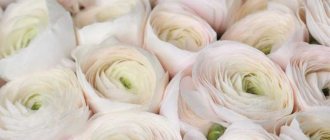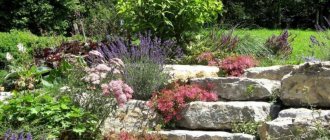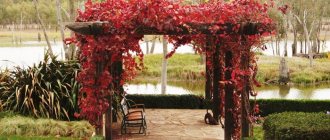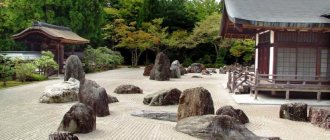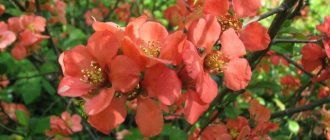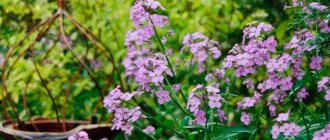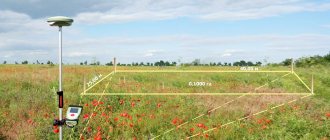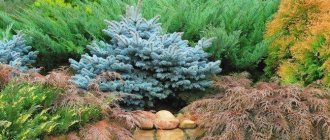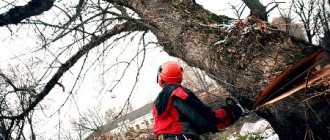Larch is a powerful tree crop, reaching a height of up to 40 meters. The tree belongs to the pine family, but unlike its representatives, in the winter the larch sheds its needles, which acquire a yellow tint in the fall. It is for this reason that it cannot be classified as an evergreen crop.
To grow this beautiful tree, it is enough to follow simple rules of caring for it and the larch will delight the gardener with its power and decorativeness for many years.
[Hide]
Types and varieties of larch
Siberian larch - grows in the Urals and Siberia. The height of the crop reaches 40 meters and has a trunk diameter of up to 100 centimeters. The crown has a round-oval shape. The bark is thick with grayish cracks. The needles are soft and narrow-linear. It has a light green tint with a bluish tint. The inflorescences of the culture are spike-shaped and pineal-shaped, female and male, pale green in color. They pollinate in May. The cones are ovoid in shape and light brown in color. After the seeds drop from them, they remain on the tree for three years, then fall off. The seeds are small, obliquely obovate. They ripen once every three years.
European larch - grows in Central and Western Europe, as well as in the Carpathians. The tree reaches a height of 50 meters, the diameter of the trunk is up to 150 centimeters. The crown has a cone-shaped or irregular shape. The bark has a brown tint with longitudinal cracks. The buds are small, apical. The needles are bunch-shaped, narrow-linear, long, soft, light green. Inflorescences are female and male. The former have a cylindrical shape and a purple tint, while the latter have an ovoid-spherical shape and a yellow tint. Flowering occurs together with the blossoming of needles. The cones have a conical shape and a brownish tint. They ripen and open the next year after emergence. They fall off after three, less often five years. Seeds appear at intervals of three to six years.

Japanese larch - grows in Japan on the island of Honshu. The culture is endemic. It reaches a height of up to 35 meters, the trunk diameter is up to 100 centimeters. The shoots have a red-brown tint and an unusual, spiral shape. The needles are long, blunt, bluish-green in color. The cones are round-oval, brown in color. The crop bears fruit once every three to five years.
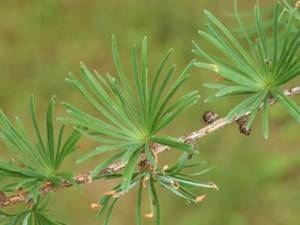
Weeping larch - this unusual type of tree is formed by pruning or special grafting. The plant has drooping branches and reaches a height of up to 8 meters. The branches are thin, uneven with a large number of processes and tubercles. The needles are soft, bunch-shaped, long green, and in the fall they turn yellow and fall off. Cones form during adulthood. They have an ovoid shape, bright colors and an incredible resemblance to small rose buds.
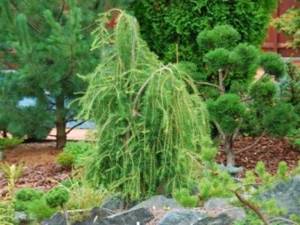
Daurian larch (Gmelina)
Grows in Taimyr. The tree reaches a height of up to 30 meters. The shoots are pinkish and sparsely hairy. The bark is thick, reddish with longitudinal cracks. The needles are bright green, long, soft, bunch-shaped. The cones are ovoid, brown. They ripen at the end of autumn.
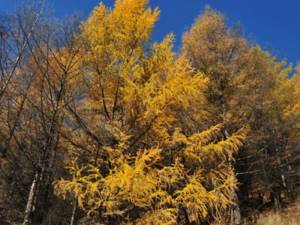
Pendula larch – grows in Europe and the Carpathians. The crown has a weeping shape with drooping branches. The height of the crop reaches 3 meters. The needles are soft, falling, bluish-green in color. Cones are female and male, red and yellow. They ripen in early autumn. After the seeds fall out, they remain on the tree for two to four years.
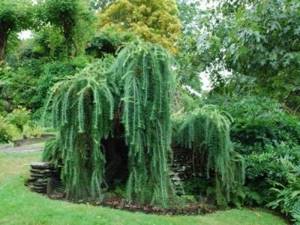
Sukachev's larch - grows in the Urals and Siberia. It reaches a height of up to 40 meters, the trunk diameter is up to 180 centimeters. The bark is grayish with cracks and deep furrows. The lateral buds are hemispherical in shape, and the apical buds are conical. The needles are narrow-linear, soft, long, light green. Inflorescences are female and male, yellow and pinkish. Pollinated in May. The cones are ovoid, brown in color. The seeds are small, winged. Ripen in autumn.

Kaempfer's larch or Thin-scaled larch - the culture reaches a height of up to 35 meters. It has long, thick, horizontal branches that form a wide pyramidal crown. The bark is thin red-brown. The needles are blue-green and long. The cones are spherical. Ripen in autumn. After falling, the seeds remain on the tree for three years.
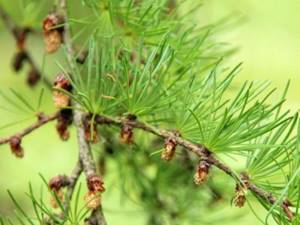
Cajander Larch
It grows on Belichye Island and on the coast of the Sea of Okhotsk. It reaches a height of up to 25 meters, the trunk diameter is up to 70 centimeters. The cones are loose, round, bare, shiny. They ripen in the fall every three to five years. The needles are long, soft, light green. The tree can grow up to 800 years.
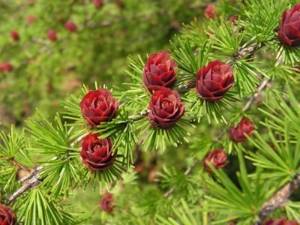
American Larch - grows in Canada and the USA. It reaches a height of up to 24 meters and has a trunk diameter of up to 60 centimeters. The crown is cone-shaped, the shoots are spiral-shaped and drooping. The bark is bare, thin, reddish-brown. Red buds. The needles are long and green. The cones are oblong, red-brown. Flowering time is in May. The crop bears fruit once every three to five years.
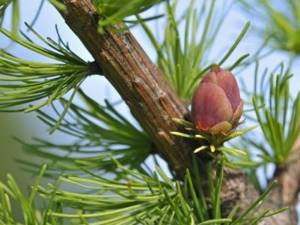
Common Larch - grows in Siberia and the Far East. The height of the crop reaches up to 50 meters, the trunk diameter is up to 1 meter. The lifespan of larch can reach up to 800 years. The crown is loose, cone-shaped. The needles are soft, long, flattened, bunch-shaped, bright green. Inflorescences are male and female, ovoid, yellowish and greenish. Pollination occurs in May, after the needles bloom. The cones are oblong-rounded, brown. Ripen in autumn. Seed years are repeated every six years.
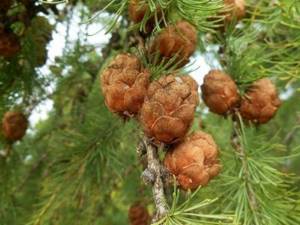
Olginskaya larch - grows in the Primorsky Territory. It reaches a height of up to 25 meters, the trunk diameter is up to 80 centimeters. The crown is irregular, the trunk is often curved. The branches are thin, red-brown. The needles are short, narrow, dark green. The cones are ovoid, brown. Ripening time is in autumn. The culture is listed in the Red Book.

Western larch
Grows in the USA and Canada for a period of 600 to 800 years. The tree reaches a height of up to 50 meters, the diameter of the trunk is up to 120 centimeters. The branches are short, the crown is narrow-pyramidal. The bark is thick, gray-brown. The needles are long, bunch-shaped, light green. The inflorescences of the crop are male and female, pollinated in May. The cones are oblong-ovate, brown. Ripen in September.
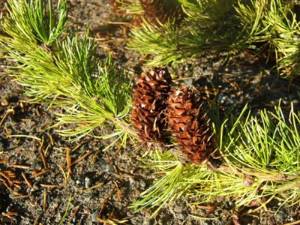
Potanin larch - grows in Nepal and China. It reaches a height of up to 30 meters. The bark is grayish with longitudinal cracks. The branches are bare, red-brown in color. The needles are keeled, light green, short. The cones are oblong-ovate, brownish-brown. They ripen and disperse in September – October.
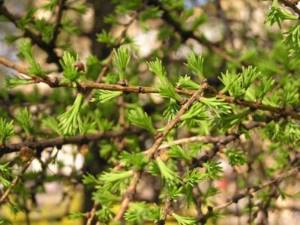
Griffith Larch - grows in the Himalayas. It reaches a height of up to 20 meters and has widely spread branches towards the side. The bark is thick, brown in color. Branches drooping, reddish. The cones are long, cylindrical, dark brown. Ripen in autumn.
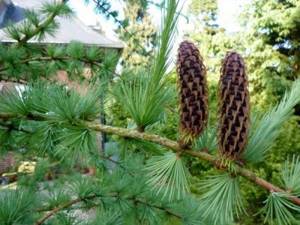
Masters larch - the tree reaches a height of up to 30 meters, a diameter of up to 100 centimeters. The branches are of medium thickness, yellowish-brown in color. The needles are bright green, long, sharp. The cones are light brown in color with purple bracts. Seed ripening occurs in early October.
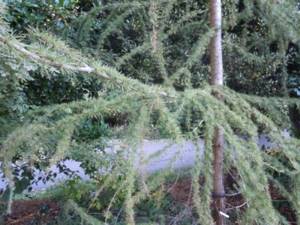
Weeping trees for the garden
Fruit trees and shrubs for the garden, columnar fruit trees
Weeping plantings began to be used in decoration many years ago. They can often be found in European style, as well as in the eastern direction of landscape design. Some weeping plantings were created by nature itself, while others were created by breeders. They are loved by designers and gardeners for their winter hardiness.
Description of willow
Willow is a deciduous plant. There are more than 600 types of it. Some of them have a shrubby growth form, some have a tree-like form.
Willow leaves are narrow and elongated. Their crown is flexible and transparent. The shoots are thin, slightly pointed. Most species do not exceed 15 meters in height, but there are several tree-like representatives that can grow up to 40 meters.
Many people still argue about: is willow a shrub or a tree? Most are inclined to think that it has 2 forms of growth. This plant is found everywhere. Willow looks great in single and composition plantings.
Shrub willow has gained wide popularity in the northern regions of Russia, as it easily tolerates harsh conditions. She is unpretentious, a frequent visitor to fires, near roads, and also on the coasts. It will grow wherever there is any (even tiny) piece of land.
Weeping willow is a shrub or willow tree that has more than 300 species and varieties in its family. The weeping form of willow differs in that, compared to other representatives of the genus, it has a very transparent crown, which is formed from thin flowing shoots. Dwarf willow trees are very often used to decorate rock gardens or organize hedges from shrub forms.
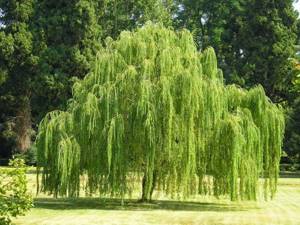
Weeping willow
Weeping cypress
This is one of the most beautiful weeping coniferous plants. Despite the fact that its homeland is China, it feels good in Russian conditions. It reaches a height of 20 to 40 meters. Scale-like leaves are densely arranged on the flowing thin shoots; from a distance they resemble branches of cheese. In addition to decorative foliage, cypress pleases with its interesting flowering, which occurs in April-May.
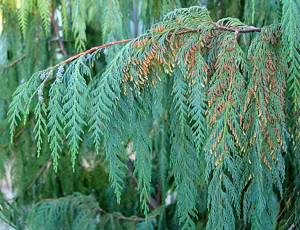
Weeping cypress blossom
Grafted plants are not new to gardening. This is how interesting tree species are created in nurseries. Weeping forms were created:
- Birches,
- Ash trees,
- Rowan trees.
The buds are not grafted in the upward direction of growth, but downward. When the shoots begin to grow, they take on the appearance of an arc and gradually begin to resemble a weeping willow, which is where the name of each of the trees comes from.
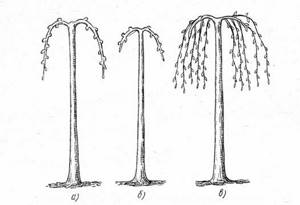
Weeping forms
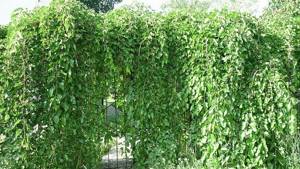
Weeping plants
Weeping rowan
An interesting plant with an irregular crown shape can add zest to landscaping. The size of the trunk depends on the level at which the back grafting was performed. This plant is very demanding of light, so you should choose an open place for planting or a slightly shaded one. You also need to take care of moisture - weeping rowan loves to keep the soil moist, but do not overdo it.
Weeping Ash
An excellent option for landscaping a lakeside area or a playground for children. The crown resembles a large tent that provides shade. After grafting, the shoots grow horizontally and later begin to bend, going down to the ground. An umbrella-shaped crown is formed on the tree. Prefers to grow in sunny or partial shade. Ash is particularly undemanding to conditions, but develops better in well-moistened soils.
Weeping Birch
A tree with a weeping crown shape, the branches of which descend to the very ground, looks picturesque when planted alone or when creating a bright composition with a pond or near gazebos. Such a plant can be propagated thanks to grafting, which is carried out directly at the top of the trunk. After grafting, you should give the plant time to recover; in the spring (before sap flow begins) it can be replanted. Prefers to grow in bright places. It is unpretentious to other conditions.
Weeping bushes
A weeping form can be created from many plants; most often, breeders use trees for this purpose. But there are shrubs that look interesting with an unusual crown shape, for example, hawthorn. From slow-growing trees or dwarf plants you can create an interesting planting for landscaping that will resemble a bush more than a tree. Such a “shrub” can be obtained from Sophora japonica. It grows very slowly, the weeping shape of the branches creates a slightly elongated ball of the tree, reminiscent of a bush.
Larch planting and care in open ground
Larch is planted in autumn or early spring, after the soil has completely thawed and warmed up. Seeds are sown in May, after the threat of frost has passed.
The area for planting the tree should be sunny. The tree doesn't like shade. In addition, with a lack of sunlight, shoots grow poorly, as a result of which the crop will look bare. You can also plant larch in a small area, but to prevent it from growing large, it needs to be subjected to formative pruning from time to time. The tree tolerates the procedure well and recovers quickly.
The crop is unpretentious to soil, but it is best not to grow it in acidic soil. If the acidity of the soil is high, then it is recommended to lime the area before planting seedlings. Larch will also grow poorly in depleted soil with a lot of sand. In order for a young tree to take root faster, grow and develop well, it needs to be planted in humus soil with good drainage.
The crop can be planted using seeds and seedlings. It is preferable to plant larch through seedlings. To plant a crop, you should prepare a planting hole measuring 50x50 centimeters. You need to transfer the seedling into the hole together with a digger, carefully placing it at the bottom of the hole and sprinkling it with a mixture of turf and peat in a 1:1 ratio. Before planting larch, a drainage layer of fine gravel should be formed at the bottom.
When planting, it is extremely important not to damage the branches, as this will lead to the tree becoming bent in the future. It is also important to ensure that the root collar is above the soil and not below it. If the soil mixture is heavy, it should be mixed with sand, and compost or humus should be added to it for nutritional value. After planting the tree, you need to water it with a bucket of water and mulch the tree trunk with a mixture of peat and sawdust.
Growing larch from seeds
It is much more difficult to get a young tree from seeds, which is why gardeners rarely use this growing method.
In order for the seed material to germinate better, it should be stratified by keeping it in water at a temperature of 25 degrees for forty-eight hours. You should only use the seeds that have sunk. After soaking, they should be mixed with wet sand and refrigerated for a month. Sowing should be carried out in May in a greenhouse, on a previously prepared, dug up, drained and fertilized area. Seed material is sown to a depth of 1 centimeter with a distance between seeds of at least 10 centimeters. After sowing, the bed must be mulched with a peat-sand mixture in a ratio of 1:3. When sprouts appear, the mulch layer must be removed. As a preventive measure, the seeds should be watered several times with a fungicide solution, and after they appear, do not forget about thinning and weeding.
When the seedlings reach the age of two years, they can be transplanted to a permanent place of growth. Since they have a low survival rate, only after ten years the gardener will begin to notice significant growth. When the sapling is five years old, it will reach a height of about 1.5 meters, and will produce its first fruits at the age of ten.
Cypress belongs to the Cypress family. It can be grown when planted and cared for in open ground without much hassle, if you follow the rules of agricultural technology. You can find all the necessary recommendations in this article.
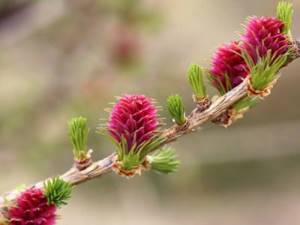
Larch on a trunk and in landscape design
Larch is widely used in landscape design.
Due to the fact that it is represented not only by large trees, but also by miniature varieties, its area of application is very extensive. It is planted in group and solitary plantings, as hedges, in rocky gardens and rock gardens. The tree tolerates proximity to other plants well. The best partners for it may be conifers, rhododendrons, linden, birch, maple, rowan, juniper, viburnum, barberry.
The compact larch on a trunk looks beautiful and unusual. Typically, varieties of European larch Kornik, Repens, and Japanese larch: Blue Dwarf, Stiff Weeper are used for cultivation in this way. They can have different types of crowns: weeping, creeping, pillow-shaped, as well as different colors of needles: dark green, bluish. Standard varieties look very beautiful near recreation areas, on the lawn, at the entrance to buildings, in alpine slides, and openwork hedges.
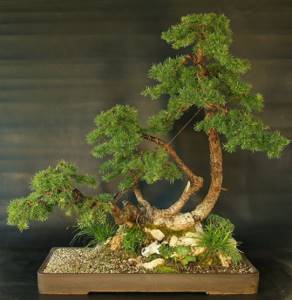
There are dwarf varieties of larch (for example, Wolterdingen) that are excellent for planting in containers and have found use in the design of Japanese gardens.
Soil for larch
The soil for the crop should be well-drained and not acidic. Therefore, before planting seedlings, the soil must be mixed with humus or compost, peat and sand. If the soil is highly acidic, it should be limed.
The ideal option for tree growth and development would be humus soil with good drainage to aerate the root system.
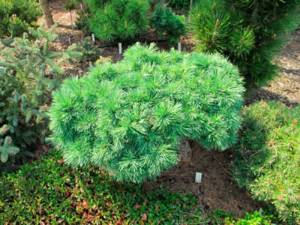
Care
Larch is unpretentious; there are no special secrets in its cultivation.
Feeding
They are carried out 2 times a year with complex fertilizers containing the main elements.
It is allowed to add organic matter once in the middle of the season. Adult, mature plants are fed once a year - in the spring, during the period of active growth.
Watering
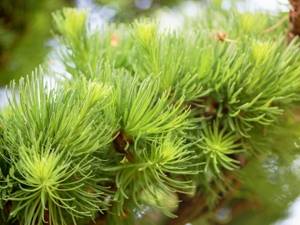
Larch does not tolerate excess moisture
Plants of this species do not tolerate excess moisture and waterlogged soils.
Typically, additional watering in spring and fall is not required.
The exception is periods of prolonged drought, when the appearance of the crown may suffer from a lack of moisture. In this case, watering is carried out once every 2 weeks, no more than 20 liters per tree.
Mulching and loosening
For mulch, finely chopped weeds, sawdust, shavings, and peat are used. The measure allows you to maintain an optimal level of humidity while reducing the frequency of watering.
It is very important to loosen the tree trunk area. It should not be carried out close to the trunk; it may damage the root hairs.
The root system itself goes deep, so the main parts are reliably protected from external factors, but need free breathing.
Neglecting the procedure leads to an increase in soil density and possible rotting of the base of the trunk and roots.
Crown formation
The decorative appearance of a plant is impossible without care. The most popular shapes for hardwood remain ball and cone.
Weeping varieties do not require frequent pruning.
The largest is the spring one, it creates the basis for most of the season and is preventive and sanitary in nature. Frozen and damaged branches are removed, their length is equalized relative to the ground, and overgrown lateral shoots are removed.
Preparing for winter
It is required in the first 1-2 years after transplantation. Particular attention is paid to insulating the root zone.
The plant is initially frost-resistant, so it tolerates winter well; in regions with strong winds, it is recommended to cover the crown with special material and secure it with tapes.
As the tree grows and develops, such measures lose relevance.
Larch transplantation
The culture does not need replanting, since it grows in one place throughout its life. Transplantation as such is needed for seedlings that are transferred from the nursery to open ground.
The procedure is carried out by transferring a young tree into a prepared hole together with a soil excavator, after which the free spaces around the seedling are filled with earth, the hole is slightly compacted, watered and mulched. It can take two to six months for larch to take root.

What do we offer?
NOBILI has been providing environmental protection services for several years now. Both individuals and organizations can contact us, and we will do everything to improve the garden or the area adjacent to the enterprise. Services also include receiving felling tickets and tree removal services. We have our own nursery in which seedlings and large-sized larch trees are grown. Our specialists will select for you strong, well-groomed specimens that will become a real decoration of your garden.
Fertilizer for larch
After planting a young tree in open ground, you should apply complex fertilizer “Kemira Universal” in a proportion of 20 grams per 1 square meter of bed. To make the tree grow faster, it can be fertilized with fertilizers containing potassium and magnesium.
In summer, the crop can be watered with a carbamide solution prepared in a ratio of 10 grams of powder per 10 liters of water. In the future, it is recommended to use fertilizers for coniferous trees according to the instructions on the package.
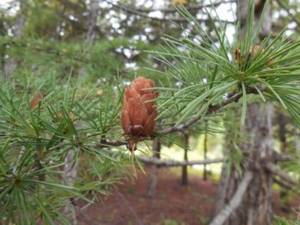
Larch care
As you already understand, larches are not afraid of the cold, in general. They grow quickly and are resistant to many negative manifestations, but not to summer drought! And then.
Watering
You need to water both at the initial stage and when your tree has already become taller than you. An adult tree needs to be given about 20 liters of water 1-2 times a week during drought!
Loosening
Only young trees need to be loosened, making sure to remove weeds, which can easily deprive the plant of light and drown it out.
Mulching
This means covering the soil under the seedlings with peat or sawdust (layer thickness approximately 5 cm) - this improves its properties.
Trimming
Moderate pruning of a young seedling will not cause harm. The main thing is not to overdo it. As mentioned above, they are very sensitive.
Shelter from frost
Most varieties tolerate them easily. But, say, it is better to cover Japanese larch in the spring, when the snow has already melted, but the risk of frost remains.
Larch blossom
Flowering in larch begins immediately after the needles bloom. The flowers of the crop are of different sexes, but are located on the same branch for more convenient pollination.
Male inflorescences are more reminiscent of something between a spikelet and a cone and have a yellow tint, female inflorescences are ovoid and resemble small rose buds of a pinkish tint.
After pollination, the female inflorescences become buds, which subsequently develop into seed cones. Larch cones can be either small or medium. Here everything will depend on the variety. After the seeds drop from them, they remain on the tree for about three years, after which they dry out and fall off.

Larch pruning
The larch crown can be pruned by removing young shoots or large knots and mature branches in early spring or autumn. By removing young branches, you can give the crown density, density and bushiness.
Pruning is performed annually, after the active growth of shoots before they become lignified. The procedure is mostly needed not to give the crown an unusual shape, but to control the height of the crop.
Pruning a tall mature tree requires a lot of time, but it should be taken into account that larch cannot be trimmed too much, otherwise the crown will be bald. Everything must be done in moderation and carefully so as not to harm the tree.

Landing Features
Under natural conditions, larch settles on sandy and loamy lands. The plant is usually located on slopes in river valleys, where there are well-drained and moist soils.
Larch roots go deep into the ground and are not afraid of temperature changes. To plant weeping larch, the following conditions are required:
- An open space well lit by sunlight is required.
- The soil should be light and fertile.
- If the soil is heavy, then you need to make good drainage.
- For weeping larch, it is important that groundwater is not located too close to the surface.
- Wet soils are not suitable, as this will lead to rotting of the entire root system.
- If the soil is acidic, it is alkalized with slaked lime.
- The time for planting is in early spring or autumn, before the buds open or the leaves fall off.
- It is necessary to choose a planting site extremely carefully, because the tree may die when transplanted.
- The age of the seedling for planting should not exceed two years.
The natural characteristics of a particular type of tree should be taken into account. When it grows in the mountains under natural conditions, it is important for it to use an alkaline substrate for planting. For the species that grows near swampy soils , highly acidic soil is suitable.
Seedlings are planted at a distance of up to three meters from each other. The root system must be deepened by eighty centimeters. After planting a tree, it is necessary to mulch with peat or sawdust.
To form a landscape composition, you need to select those plants that will go well with larch. These are spreading ferns, tall sedums. Azaleas and rhododendrons will look great in flower beds next to a weeping tree. The red foliage of the broom looks luxurious against the background of the bluish needles of the weeping pendula . Astilbe can be planted in the foreground of the composition.
Secluded gazebos decorated with trees with hanging crowns look especially attractive. You can use not only other plants, but also stones to stylize the design.
Therefore, the choice of a site for planting weeping larch should include all the details of the future landscape composition, because it is necessary to more accurately calculate the location of the tree, its future height and crown shape.
Larch propagation
Larch can be propagated by seed (seedlings) and cuttings. Larch does not reproduce by spores, although such a request is found quite often on the Internet.
To propagate a crop by seed, it is necessary to stratify the seed material for three months, keeping it in the refrigerator or on the balcony, if the temperature there does not fall below 5 degrees. To do this, the seeds need to be sown in a damp mixture of peat and sand and ensure that it does not dry out while stratification is carried out.
With the onset of early spring, the container must be moved to a warm place and watering increased. We should not forget about the drainage holes in the planting container. After the seedlings appear, they need to be taken outside and kept there until late autumn. When it gets colder, the container with seedlings needs to be placed indoors.
In winter, you need to ensure that the room is cool and the soil is always slightly moist. The air should also not be too dry. When the seedlings are two years old, they can be transferred to open ground by carrying out the procedure in mid-May.
Only experienced gardeners or nursery owners use cuttings. This technique is very complex and does not always give the expected results. Seedlings obtained by cuttings can be planted in open ground after reaching two years of age.
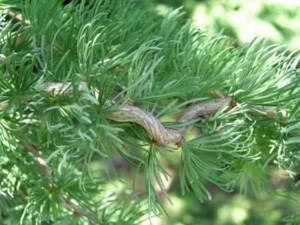
What to look for when buying seedlings
How to grow larch?
There are two ways - seedlings or seeds. Seedlings must be two to four years old. It is better to purchase plants in containers. When purchasing, pay attention to the tips of the needles - they should not be dry. The branches should bend, not lean to the sides.
Read also: Amaryllis: features of flower care at home
However, sometimes it is quite difficult to buy larch seedlings. Therefore, it is often sown with seeds, which are extracted independently from the cones at the end of October or purchased in specialized stores. Before planting, they must be stored in a paper bag. Seeds remain viable for two to three years.
Diseases and pests
Larch, like the entire conifer family, is subject to some dangerous ailments, among which we should highlight:
- Larch cancer is a disease that, unfortunately, cannot be cured and it leads to the complete destruction of the tree. It manifests itself in the appearance of shiny spots on the trunk, from which resin begins to flow.
- Fusarium - most often seedlings suffer from it. To prevent its occurrence, soil with plants must be treated from time to time with solutions of manganese and copper sulfate.
- Schutta - this disease manifests itself in the redness of the needles, which appears at the end of May. To prevent the disease, it is enough to treat the culture with a solution of colloidal sulfur.
Of the pests, the greatest danger to larch is caused by polypores, pine bugs, moth caterpillars, aphids and greenish hermes. You can get rid of them by treating the tree with a solution of the Actellik insecticide according to the instructions on the package at an interval of fourteen days.
Shedding needles in the fall is typical for larch, but what to do if the needles begin to turn yellow and fall off in the spring? The cause of this problem is a disease caused by mold fungi that live in last year's needles and are spread by spores. To prevent the development of this disease, in the spring it is necessary to remove last year's needles from under the tree and treat the tree with a solution of antifungal fungicides several times during the season.

Pests
- Brown aphid . It is treated by washing the damaged areas with a soap solution.
- Spruce-leaf red hermes aphid . Treatment is treatment of larch with insecticidal preparations.

Hermes aphids are a common pest.
- Scaleworms. Treatment is repeated treatment of the tree with tobacco solution.
- Berry bug. Treatment is spraying with insecticidal preparations.
- Larch cap moth . Spraying with herbal and insecticidal preparations is effective.
- Sawfly. To get rid of the pest, you should dig up the soil around the trunk and eliminate the sawfly nests, and treat the tree with an insecticide.
- Leaf roller. First, the nests of the larvae are destroyed, and the tree is sprayed with insecticidal decoctions with mineral oil.
- Bristle weevil. It is necessary to prune damaged shoots and spray the tree with an insecticide based on mineral oils.
- Kidney gall midge . Treatment with insecticides is carried out.
- Larch moth. Spraying with insecticidal preparations is carried out.
- Cone fire. Treated with insecticides.
- Larch flies . For treatment, first destroy the nests of the pest by digging up the soil in the tree trunk area. Caterpillars and larvae are sprayed with systemic insecticides and herbal infusions.
- Spruce woodcutter. The pest is destroyed by treating the crown, trunk and soil around it with insecticides in the spring and during the period of mass flight of beetles.
Larch medicinal properties and use in medicine
Larch products consist of essential oil, tannins, ascorbic acid, organic acids, anthocyanins, gums and flavonoids. In medicine, larch resin, buds, bark and pine needles are used. Buds are collected in the spring, needles in the summer, and resin in the spring during the growing season. It contains rosin, essential oil and abietic acid.
In folk medicine, needles are used to prevent many ailments. It is used as a laxative and hemostatic agent. Infusions from pine needles help with gout and rheumatism. The essential oil included in its composition helps treat bronchitis and runny nose.
Larch bark is used in the treatment of hemorrhoids, abscesses and trophic lesions. Decoctions from it are used to strengthen the immune system and treat prostatitis.
Larch buds are used to make infusions that help with mental and physical exhaustion, as well as gastrointestinal diseases.
Resin or resin includes essential oils and abietic acid. It has anti-inflammatory, anti-scorbutic, wound-healing, antimicrobial, analgesic and strengthening properties. It is used for diseases of the oral cavity, diabetes, kidney, liver and cardiovascular diseases. It perfectly relieves inflammation and heals wounds.
Larch gum is a component of resin. It is a natural antioxidant that prevents the development of cancer tumors. In addition, it strengthens blood vessels, removes toxins, lowers cholesterol and reduces appetite.
Despite the fact that larch brings benefits to the body, its products also have contraindications. You should not use larch-based preparations during pregnancy, individual intolerance, peptic ulcer disease at the acute stage, pathologies of the central nervous system and the first few months after a heart attack or stroke.
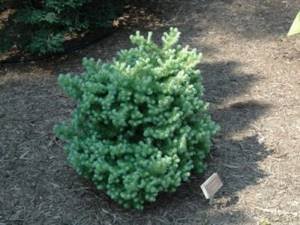
Growing larch: highlights
Larch is a common coniferous tree in Russia. This plant differs from other evergreen species in that it sheds its needles in the fall. Larch is valued for its unique medicinal properties. Almost all parts of the plant (needles, branches, shoots and resin) are used to treat various diseases (hemorrhoids, tonsillitis, bronchitis and others). Growing larch on your site will help to significantly cleanse and improve the surrounding atmosphere.
Read also: Features of the fight against dandelions in the garden: how to remove the weed
